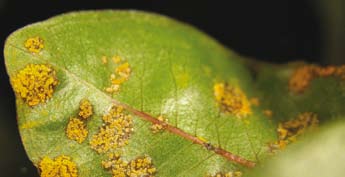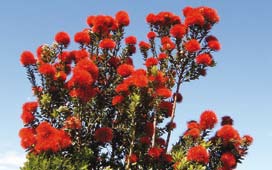PESTS AND DISEASES OF FORESTRY IN NEW ZEALAND
Guava rust: a step closer to New Zealand
From Biosecurity 69, August 2006.
Guava rust (Puccinia psidii) is a serious fungal disease that affects plants in the myrtle family (family Myrtaceae). In Hawaii last year, guava rust symptoms were found on seedlings of ohia, a species closely related to our pohutukawa and rata trees. While guava rust has been previously known from Central and South America and also in Florida and Taiwan, its arrival in Hawaii last year has prompted increased concern that this species may arrive in Australia or New Zealand.

Guava rust causes powdery pustules on leaves, which progress to deformation of leaves and shoots and sometimes dieback if the infection is severe (see illustration). Flowers and fruit can also be affected.
The disease has previously been identified as a threat to both Australia and New Zealand. In Australia, there are particular concerns about the effect on eucalypts. Because it is known to affect Australian eucalypts in areas such as South America, it is often known as ‘eucalyptus rust’.
In New Zealand, there are a number of species in the myrtle family considered to be at risk if guava rust arrives, among them iconic natives such as pohutukawa, rata and manuka. Introduced species such as feijoa, and, of course, eucalypts, are also expected to be affected if the disease establishes here.
Because guava rust is a subtropical species, it is most likely to establish in the very far north of New Zealand, although establishment elsewhere cannot be ruled out. The critically endangered tree known as Bartlett’s rata is found only in the very far north of New Zealand and guava rust could threaten this species if it arrives.

Both New Zealand and Australia currently have strict measures on material that may carry guava rust (especially nursery stock). These measures were updated over the last year to account for the new distribution of guava rust and also the new hosts that have been reported. Over the coming year, more work is planned to ensure that New Zealand is protected from this disease.
A pest risk analysis will be done so that we can better understand the risk to New Zealand and to thoroughly review the measures that we have in place for this pest. An economic impact assessment is also planned. This will provide information to support the risk analysis and, if necessary, any response if it arrives.
Biosecurity New Zealand staff are also working with Australia to identify approaches to managing this disease. Rust diseases are notoriously difficult to control, however, and so prevention is our priority.
For further information or to be kept updated on this work please contact:
Christine Reed, Group Manager Risk Analysis, Biosecurity New Zealand, phone 04 894 0729, christine reed@maf govt nz

 Farm Forestry New Zealand
Farm Forestry New Zealand

